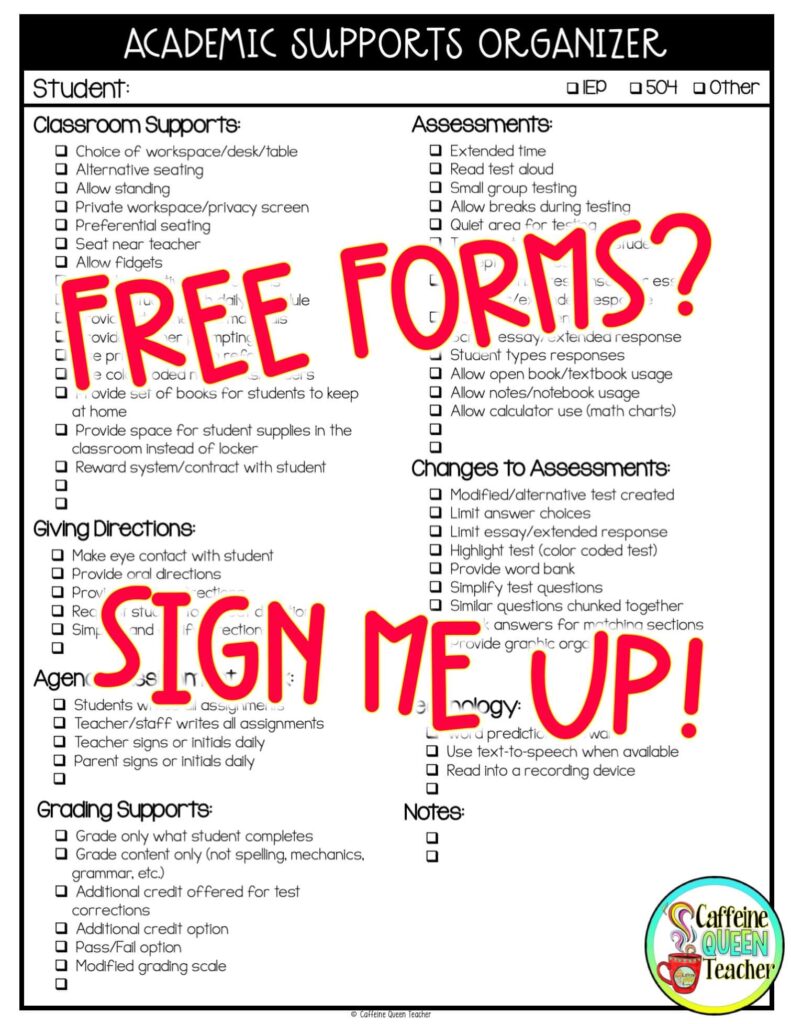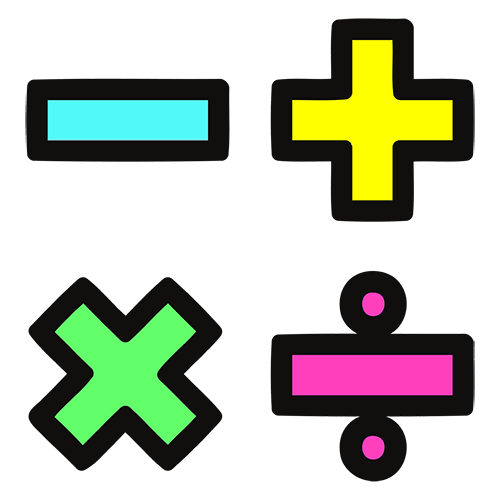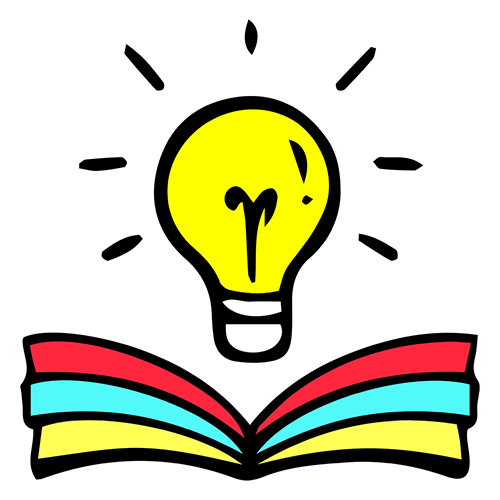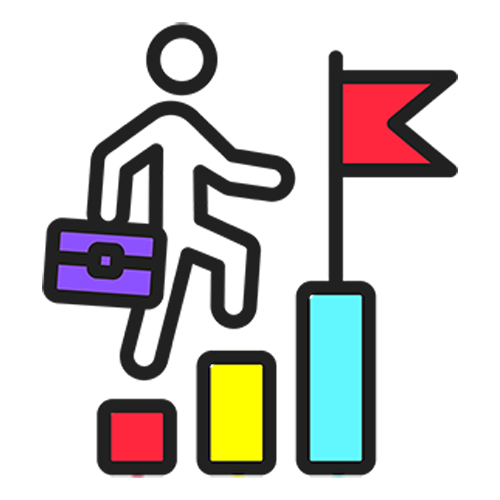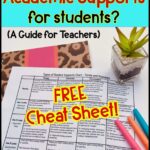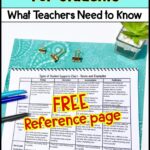Accommodations vs. Modifications. Strategies vs. Interventions. What’s the difference? Read on to find the answer and learn what every teacher needs to know about academic supports for students.
I’ll never forget sitting in an IEP meeting during my first year of teaching.
As a new teacher, I had prepared as much as I could, but I always felt nervous. Unexpected questions often popped up during the meetings.
In one particular meeting, a parent asked me to explain the differences between academic support terms like accommodations and modifications.
It was an intimidating moment for me, and my face flushed hot with panic. To be honest, at that time, I thought they were all the same.
I stumbled my way through an answer, but unfortunately, no one else at the table jumped in to save me.
To say I felt embarrassed and humiliated is an understatement.
Looking back on it now, though, I wonder just how many others at the table were as confused about these terms as I was.
I took that situation as an opportunity to learn the difference between strategies, accommodations, modifications, and interventions – terms often used interchangeably – and incorrectly.
That lesson stayed with me for my entire teaching career.
I don’t want YOU to experience such embarrassment or humiliation so let’s dig into four academic support terms for students: Strategy, Intervention, Accommodation, and Modification.
*By the way – read to the end and learn how to grab the FREE Cheat Sheet!

Types of Academic Supports for Students:
1. Strategies:
Strategies refer to specific approaches teachers use to support learning and boost success. They benefit all students. Most teachers use a variety of strategies in their daily instruction.
Classroom Instruction
For classroom instruction, strategies should be chosen based on the needs of particular students or the class. They often use repetition and explicit instruction to reduce confusion as students learn difficult concepts. Strategies often incorporate multi-sensory methods, such as visuals, music, and movement activities. Most teachers use a variety of strategies every day.
Examples of strategies include anticipatory sets (previewing material before it’s introduced), summarizing information after it’s been presented (to reinforce understanding), cooperative learning, task cards, and Think-Pair-Share.

2. Interventions:
Interventions are specialized instruction, strategies, or procedures tailored specifically for individual children who have not benefited from regular classroom teaching strategies.
They’re usually progress monitored, meaning data is collected. Interventions target specific skill sets that students must improve to close a skill gap. An intervention is taught in addition to the regular curriculum, not in place of it. It involves teaching new skills to help students overcome an area of difficulty. Interventions should lead to improved learning and success.
Classroom Instruction
Interventions typically focus on reinforcing skills such as phonemic awareness (the ability to hear sounds within words) or letter-sound recognition (segmenting words into individual phonemes). They might involve extra practice with math facts or organizational skills. They’re aimed at helping students become more successful learners overall.
In addition to regular classroom instruction, interventions are extra lessons and activities designed to close their learning gap. For example, students may attend a small group or one-on-one instruction tailored to their needs in a specific skill area. Interventions can be provided by classroom teachers, support teachers, other school staff, or school volunteers.
Examples include DIBELS – Acadience, specific phonics programs, and behavior programs.
Testing
Students receiving intervention may take diagnostic tests and receive ongoing monitoring to ensure progress.

3. Accommodations:
Accommodations DO NOT change the curriculum or what students are expected to learn. Students are expected to learn the same curriculum, but the learning methods may be different. In other words, accommodations change how students learn the material.
Accommodations are changes made to the classroom environment or instruction that allow a student to access the general curriculum despite their disability.
Accommodations are commonly seen on 504 Plans and IEPs. For teachers and students working with those plans, accommodations aren’t choices; they are legally required and must be followed as written. No wiggle room.
Classroom Instruction
Students are expected to learn the same curriculum, but the learning methods may be different. Accommodations should allow students to learn in a way that suits their needs and skills without giving them an unfair advantage. Accommodations are provided by various school staff, including teachers, special educators, and others.
For example, a student with vision impairments may require enlarged copies of text materials to be able to read them comfortably. An auditory learner may need more breaks throughout the day to stay focused on learning activities. Accommodations can also include giving students extra time on assignments and providing verbal and written directions.
Classroom Testing
When it comes to testing, students receiving accommodations receive the same content, complexity, and test questions as students without accommodations. The delivery, test style, or testing location may be different.
Examples include students testing in a small group setting, students providing oral answers instead of written answers, or taking a paper and pencil test rather than an online or computer test. Those types of changes don’t affect the actual questions or content complexity.
Standardized testing accommodations may or may not be different than classroom testing accommodations. You’ll have to check your state’s testing manual for specifics. Every state follows different guidelines for standardized testing, and updates frequently happen in education.
4. Modifications:
Modifications DO change the curriculum and what students are expected to learn.
Curriculum changes DO affect the content, complexity, volume, expectations, and/or pacing of the material taught to students. They change what students learn or how they demonstrate their knowledge. Modifications change how much material a student is expected to master by simplifying it or by eliminating certain topics.
Modifications are often associated with special education services and are commonly seen in IEPs. They are specific and individualized for each student.
Classroom Instruction
Students receiving modifications are not expected to learn the same curriculum, so instruction or assignments are differentiated or changed. Those changes are based on the needs and strengths of the individual students. Modifications are provided by school staff, including teachers, special educators, and other school staff.
For example, a teacher might assign only certain pages instead of a whole chapter. Other examples include different spelling lists, reduced or different vocabulary words, alternative or shortened assignments, or a different grading scale.
Classroom Testing
Students receiving modifications commonly take different, alternate tests than their peers. The alternate test may be shorter, less complex, or entirely different in another way.
Examples include testing over different or less complex material, reduced choices on a test, different test styles (essay vs. multiple choice), and a different grading scale, such as Pass/Fail.
Standardized testing modifications can include alternate assessments in place of typical statewide grade-level tests. Guidelines and qualifications for students are different in each state, so check your state’s testing manual for specific information.
One More Thing About Academic Supports for Students-
Now that you know the difference between types of academic support for students, one final important guideline to keep in mind is this: Depending on its use, a support can be classified differently than this article indicates.
For example, think about providing a calculator to a student. If that student knows his facts, it’s an accommodation. If the student doesn’t know his facts, it’s a modification.
Ultimately, the difference lies with the intent. For example, if the intent of a given support is to lessen complexity, the support is probably a modification.
Remember – Use the information in this article as a guide, not an absolute. Supports can vary across schools, districts, states, and countries. Use this guide as a conversation starter with teachers, administrators, and parents.
Always do what’s best for kids – no matter what you call the support.
Supports are meant to do just that – SUPPORT students and provide just the right level of help they need to be successful – no more, no less.
So – the next time someone asks what the difference is between an accommodation and a modification, you can pipe up with just the correct answer!
*Want a FREE reference sheet about this?
Grab the FREE Academic Supports Cheat Sheet by clicking the photo below!
Looking for an IEP Checklist of Student Accommodations and Modifications for your teaching binder? Click here or the picture below to read more and grab the FREE checklist!
